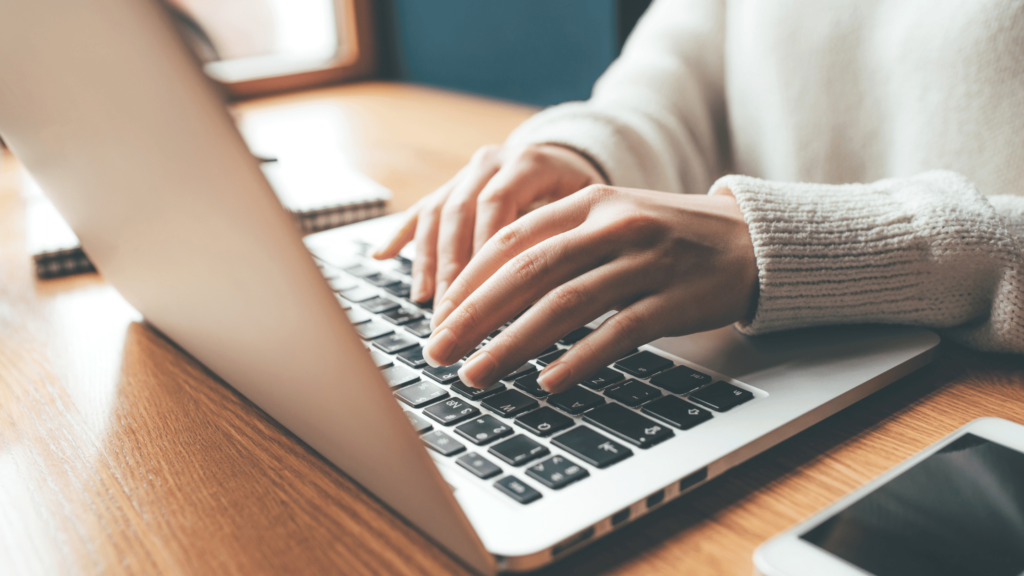Resume writing tips for making a strong first impression
Be brief, clear and concise
On average, a recruiter spends about 5 seconds scanning a resume before deciding whether to discard it or consider it further. This extremely limited time frame underscores the necessity of crafting a resume that immediately grabs attention and clearly communicates your qualifications.
By presenting your most compelling achievements and skills in a concise, organized format, you ensure that key information jumps out at the reader. This sharp focus and clear presentation are crucial in making a memorable impression that can sway the recruiter to spend additional time on your application, increasing your chances of progressing to the next stage of the hiring process.
As the old saying goes: less is more—trim your resume to showcase only your strongest qualifications, ensuring clarity and impact.”
Chose the right resume format: chronological, functional, or combination
Choosing the right resume format is a crucial first step in effectively highlighting your experience and skills for the job. The three main types of resume formats—chronological, functional, and combination—serve different purposes and suit various career needs.
A chronological resume lists your work history in reverse chronological order, starting with the most recent position you’ve held, emphasizing a steady work history and progression in a particular field. This format is straightforward and preferred by many hiring managers because it clearly shows your career trajectory.
On the other hand, a functional resume focuses on your skills and experiences rather than your job history. This format is ideal for those with gaps in employment or who are transitioning to a new industry.
The combination resume, as the name suggests, merges elements of both, highlighting relevant skills at the top followed by a chronological work history. This can be particularly effective for candidates with strong skills that are directly applicable to the job but also want to showcase a solid employment record.
For a deeper dive into when and how to use each type, you can read our detailed comparison in the blog post Chronological vs. Functional Resume Formats.
Use a professional resume template and formatting
Starting with a professional template can give your resume a clean, organized layout that catches the eye of hiring managers.
While templates provide a solid structural backbone, using a resume builder like careerpilot.ai can significantly enhance the resume writing process. Careerpilot.ai offers a variety of templates and incorporates AI-assisted writing tools that help you craft compelling content tailored to your career goals. These tools guide you in emphasizing the right skills and experiences, ensuring that your resume is not only aesthetically pleasing but also optimized for both readability and for the applicant tracking system.
The combination of a well-chosen template and the advanced features of a resume builder can simplify the creation of a personalized and professional resume, making this crucial task less daunting and more efficient.
Ensure accurate contact information and professional email addresses
Ensuring that your contact information is accurate and your email address appears professional is essential in making sure that you hear back from the jobs you apply to. Always double-check that your phone number, email address, and LinkedIn profile (if included) are current and error-free to avoid missing crucial communications about your job application.
You should also make sure to use a professional email. If you’re still using an email you created in high school (example: “[email protected]”) you might want to opt for something a bit more professional on your resume.
Even something as simple as the choice of your email provider can have an impact on the perception of your tech-savveness and professionalism. Using outdated services like Hotmail or AOL might give an impression of being out of touch with current technology trends. Instead, use a simple and professional email format, such as “[email protected]”, which is straightforward and universally acceptable.
This attention to detail ensures you present yourself in the most professional light possible right from the first point of contact.

Craft a compelling resume headline
Crafting a compelling headline for your resume is like setting the hook in a captivating novel—it grabs attention and encourages further reading. Your headline should concisely convey your professional identity, core competencies and the value you bring, tailored to the role you are applying for.
For example, instead of a generic “Experienced Marketing Professional,” a more targeted headline could be “Digital Marketing Specialist with 5+ Years of Proven ROI Enhancement.” This not only specifies your expertise but also highlights a key accomplishment that is likely to resonate with potential employers, making your resume stand out in a crowded field.
Use a resume summary instead of an objective statement
Using a resume summary instead of an objective statement can significantly enhance the effectiveness of your resume. A summary statement focuses on what you can offer the employer, not what you seek from the job, showcasing your qualifications and achievements right off the bat.
This brief section—usually 3-4 sentences—should highlight your key experiences, skills, and any specific accomplishments that align with the needs of the position. It’s tailored to demonstrate your value proposition to potential employers, emphasizing how your background makes you a perfect fit for the role.
This approach not only positions you as a proactive candidate but also allows hiring managers to immediately see the benefits of considering your candidacy, making it a powerful tool for making a strong first impression.
Use important keywords from the job description
Using important keywords from the job description in your resume is a strategic move that can significantly increase your chances of getting past both the initial ATS screening and catching the eye of hiring managers.
These keywords typically encompass specific skills, relevant qualifications, job titles, and other industry-related terms that are essential for the role. By mirroring the language used in the job description, you not only demonstrate that you are a strong match for the position but also ensure that your resume is optimized for the keywords that the ATS is programmed to recognize.
Consider using professional tools or services like careerpilot.ai, which can analyze your resume against job descriptions to suggest the most effective keywords and phrases. This targeted approach ensures your resume speaks the same language as hiring managers and ATS systems, boosting your chances of making a lasting impression.
Use action verbs and achievement focused bullet points
Enhance your resume by using action verbs and quantifying your achievements to clearly demonstrate your professional impact and accomplishments. Employ action verbs such as “achieved,” “expanded,” “developed,” and “reduced” to actively describe your role in the accomplishment of different tasks, projects and initiatives. Additionally, by quantifying these successes with specific figures, you provide tangible proof of your skills and effectiveness.
For example, instead of simply stating you “managed a team,” specify that you “led a team of 10, achieving a 30% increase in revenue over six months.” Instead of “responsible for budgeting,” more precisely indicate that you “reduced annual costs by $40,000 through strategic supplier negotiations.” This approach not only clarifies your contributions but also highlights your achievements, making your resume more compelling and distinguishable in the job market.
How to List Experience and Education

List relevant jobs in your professional experience section
To ensure your work experience section makes a powerful impact, tailor your relevant experience to resonate with the requirements of the job you’re targeting. Start by formatting each entry with your job title, the company’s name, location, and your dates of employment, presented in reverse chronological order. If your most recent position isn’t the most relevant piece of your candidacy, consider leading with a skills section (such as in a hybrid resume format)
Prioritize and place the most relevant and impressive achievements at the top of each job entry. Use concise bullet points led by dynamic action verbs and include quantifiable results whenever possible, such as revenue growth percentages or efficiencies gained. This prioritization ensures that the hiring manager sees your most pertinent accomplishments first, effectively showcasing your suitability for the role right away. This approach not only illustrates your qualifications but also aligns your career narrative with the prospective employer’s objectives, enhancing your resume’s effectiveness by immediately drawing attention to your most compelling experiences.
If your recent experiences don’t directly align with the job you’re aiming for, or if you are changing careers, consider using a functional resume format. This style focuses on your skills and abilities rather than your chronological work history, allowing you to highlight how your overall experiences and competencies make you a suitable candidate for the position, despite not having a linear career path in the field.
Include internships, volunteer work, and side projects
Internships, volunteer work, and side projects can significantly enrich your resume, particularly in the early stages of your career when practical experience may be limited. These activities demonstrate your initiative, willingness to learn, and commitment to personal and professional growth.
Internships offer valuable insights and industry-specific skills, while volunteer work can highlight your leadership abilities and commitment to community. Side projects are a great way to showcase your entrepreneurial spirit and capacity to see projects through independently.
For more seasoned professionals, while internships might become less relevant, the skills and experiences gained from ongoing volunteer work and side projects continue to demonstrate your dedication to expanding your expertise and engaging meaningfully with your industry or community.
Position your educational background effectively
Effectively positioning your educational background on your resume involves more than just listing degrees; it’s about highlighting your academic achievements in a way that aligns with your career goals.
Place your education section towards the top of your resume if you’re a recent graduate or if your educational credentials are particularly strong or directly relevant to the job. For each degree, include the name of the institution, your degree, field of study, and graduation year. Enhance this section by adding any honors, scholarships, or GPA if they are impressive and relevant.
Additionally, if you’ve completed any courses or certifications that are pertinent to the job you’re applying for, make sure to include these to demonstrate your commitment to continuous learning and professional development. This strategy ensures that potential employers immediately recognize the relevance of your academic experiences to the position at hand.
Include certifications and online courses
Including relevant certifications and online courses on your resume is an excellent way to demonstrate ongoing professional development and specific skills relevant to your career path. Platforms like Coursera and edX offer courses and certifications from recognized institutions across the globe, covering a vast range of subjects and industries.
For example, a digital marketing professional might enhance their resume with a Google Analytics certification from Coursera, showing not only their expertise in analytics but also their commitment to staying current in a rapidly evolving field. Similarly, someone in the project management field might include a Project Management Professional (PMP) certification or specialized courses from edX related to agile methodologies.
Adding these credentials helps to build a more compelling case for your candidacy, signaling to potential employers that you are proactive about learning and applying the latest skills in your industry.
Be intentional about career gaps
When it comes to explaining career gaps on your resume, it’s all about framing them in a light that reflects your proactive character and continual growth. If there’s a break in your employment history, don’t just leave a blank space—use it as an opportunity to highlight any constructive activities you were involved in during that time. Whether you were pursuing further education, volunteering, or traveling, share how these experiences have enriched your skills or broadened your perspective, making you a better candidate for the job.
For instance, you could mention a relevant workshop you attended, community service that enhanced your leadership skills, or freelance projects that kept your industry knowledge sharp. This approach helps paint a picture of a well-rounded, proactive individual, turning potential concerns into positives.
Highlighting Your Soft and Transferable Skills
When it comes to rounding out your resume, don’t forget to showcase your soft skills and transferable skills alongside your technical abilities. These are the qualities like teamwork, communication, problem-solving, and adaptability that truly paint a full picture of who you are as a professional. Mention these skills in the context of how they’ve positively impacted your past roles—perhaps your strong communication skills led to more effective team collaborations or your adaptability helped navigate a major project through unexpected changes.
Including these skills can really resonate with hiring managers, as they are crucial for almost every position and demonstrate that you’re not just capable of doing the job, but that you’ll enhance the workplace environment too.
Design & layout tips for a resume

Use a professional resume design and layout
When it comes to your resume, the layout and design play a huge role in making sure it stands out from the stack. A clean, professional design not only catches the eye but also makes it easier for hiring managers to find the most important information about you. That’s where using a professional resume template can really come in handy. Services like Careerpilot.ai offer a range of templates that are not only sleek and stylish but also tailored to present your information in the most effective way possible.
By choosing the right template, you ensure that your resume isn’t just another sheet of paper—it’s a polished introduction to your professional capabilities. Plus, a great design can leave a lasting impression, making your application memorable.
Hiring managers prefer bullet points to improve readability
Using bullet points in your resume is like giving your readers a breath of fresh air; it breaks up dense blocks of text and directs their attention to your key achievements and skills. This simple formatting trick makes your resume much easier to scan quickly, ensuring that hiring managers can spot the important details without getting lost in lengthy paragraphs.
Not only does this make your resume more reader-friendly, but it also helps emphasize your accomplishments and experiences in a clear, organized way. Remember, when it comes to resumes, readability is key to making a strong impression, and bullet points are your allies in highlighting what you bring to the table efficiently and effectively.
Chose the right font type and size for your resume
Choosing the right font type and size for your resume might seem like a small detail, but it can make a big difference in how professional and readable your document appears. Stick with classic, easy-to-read fonts like Arial, Calibri, or Times New Roman, and keep your font size between 10 and 12 points. This ensures that your resume not only looks clean and sharp but is also easy on the eyes of hiring managers who may be scanning through dozens of applications.
A well-chosen font helps convey your information in a clear, accessible way, making your resume both appealing and practical. Remember, the goal is to make it as easy as possible for recruiters to see why you’re the right fit for the job!
Should I include a photo on my resume?
Deciding whether to include a photo on your resume can depend heavily on where you are applying and the industry norms. In some countries, like the U.S., adding a photo is not standard practice and could potentially lead to bias in the hiring process. However, in many European countries, such as Germany or France, including a professional photo is often expected.
As for different industries, if you’re applying for a role in the creative sectors like fashion or entertainment, a photo might enhance your resume by giving it a personal touch. On the other hand, for more traditional fields such as law or finance, it’s generally more appropriate to keep your resume strictly professional with just text.
Always consider the norms of the region and industry when deciding whether to add a photo to your resume, ensuring it aligns with expectations and enhances your chances of securing an interview. Additionally, if you’re hesitant about including a photo directly on your resume, you can simply add a link to your LinkedIn profile. This allows recruiters and hiring managers the option to view your profile with a photo, providing a more complete picture of your professional persona while maintaining the formal standards of your resume.
Save your resume in the right file format
When saving your resume, it’s really important to pick the right file format to make sure it opens easily and reads well on any system, including hiring managers’ computers and applicant tracking systems (ATS). The safest bet is often a PDF since it keeps your layout and design looking good no matter where it’s opened.
But keep an eye on the job posting—sometimes an employer will ask for a specific format, like a Microsoft Word document. Following these instructions is key for making sure your resume plays nice with their ATS.
Also, be smart about your file name. Start with your full name and then the job title you’re applying for, like “JohnDoe_ProjectManager.pdf”. This helps hiring managers keep track of your application and instantly tells them who you are and what you’re aiming for.
Roundup on Do’s and Don’t s for your resume

Resume Do’s
-
Do Tailor Your Resume for Each Job: Customize your resume to match the job description, highlighting important skills and experiences that align closely with the specific position.
-
Do Use Action Verbs: Start bullet points with action verbs like “Managed,” “Developed,” or “Increased” to make your accomplishments stand out.
-
Do Include Quantifiable Achievements: Whenever possible, add numbers to your achievements, such as percentages or dollar amounts, to show your tangible impact.
- Do Keep It Concise: Stick to one or two pages maximum. Only include information that is relevant to the job you’re applying for.
- Do Use a Professional Format: Opt for a clean and simple layout that is easy to read and looks professional.
- Do Proofread Multiple Times: Avoid spelling and grammar errors at all costs to maintain professionalism.
- Do Include a Link to Your LinkedIn Profile:
Make sure it’s up-to-date and provides a broader picture of your professional life.
Resume Don’ts
Don’t Include Irrelevant Information: Skip the details that don’t add value to the specific job you are targeting.
Don’t Use Personal Pronouns: Keep it professional and concise by omitting “I,” “me,” and “my.”
Don’t Include a Photo (Unless Required): In most professional fields and especially in the U.S., adding a photo is not standard and can be seen as unprofessional.
Don’t Lie or Exaggerate: Stay honest about your skills and experiences. Being truthful is key to avoiding potential issues down the line.
Don’t Use an Unprofessional Email Address: Always opt for a simple email format that includes your name, such as [email protected].
Don’t Use Dense Blocks of Text: Break up information into bullet points to improve readability and scanability.
Don’t Forget to Update Regularly: Make sure that all information is current and reflects your most recent achievements and job roles.






